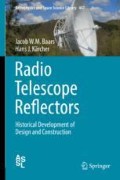Abstract
In Germany in 1904, Christian Hülsmeyer used a copy of Hertz’s apparatus to demonstrate the reception of radiation reflected from a ship, thereby introducing a first primitive version of radar, albeit without range information. In the early years of the twentieth century, the ingenious inventor Guglielmo Marconi (1874–1937) was instrumental in the development of radio communication and broadcasting at long wavelengths of deca- and hectometres. The antennas were wire dipoles. In the early 1930s, Marconi used parabolic dishes of 3 m diameter in a demonstration of telephony across the English Channel at a frequency near 1.7 GHz. Radar was developed in several countries in the late 1930s and was put to use intensely in World War II, using paraboloidal reflectors at decimetre wavelengths. Great secrecy surrounded these latter activities.
References
Bolton, J.G.: Radio astronomy with Australian 210-foot telescope. Proc. IEEE. 51, 1464–1470 (1963)
Bowen, E.G., Minnett, H.C.: The Australian 210-ft radio telescope. J. Br. IRE. 23, 49–53 (1962)
Christiansen, W.N., Hindman, J.V.: A preliminary survey of 1420 Mc/s line emission from galactic hydrogen. Aust. J. Sci. Res. A5, 437–455 (1952)
Ewen, H.I., Purcell, E.M.: Radiation from galactic hydrogen at 1420 Mc/s. Nature. 168, 356 (1951)
Fanning, W.R.: Mechanical design of the Haystack antenna. Design and construction of large steerable aerials. IEE Conf. Publ. 21, 100–104 (1966)
Findlay, J.W.: The 300-foot radio telescope at Green Bank. Sky Telescope. 25, 68 (1963)
Ingalls, R.P., et al.: Upgrading the Haystack radio telescope for operation at 115 GHz. Proc. IEEE. 82, 742–755 (1994)
Jansky, K.G.: Eletrical disturbances apparently of extraterrestrial origin. Proc. IRE. 21, 1387–1398 (1933)
Kiepenheuer, K.O.: Cosmic rays as the source of general galactic radio emission. Phys. Rev. 79, 738–739 (1950)
Lockman, F.J., Ghigo, F.D., Balse, D.S.: But it was fun – the first forty years of radio astronomy at Green Bank. NRAO, Green Bank (2007)
Lovell, A.C.B.: The Jodrell Bank radio telescope. Nature. 180, 60–62 (1957)
Lovell, B.: The Jodrell Bank telescopes. Oxford University Press, New York (1985)
Lovell, B., Husband, H.C.: Blue Book (1951). Downloadable from Jodrell Bank Observatory site: http://www.jb.man.ac.uk/aboutus/lovell/bluebook/
Muller, C.A., Oort, J.H.: The interstellar hydrogen line at 1420 Mc/s and an estimate of galactic rotation. Nature. 168, 357–358 (1951)
Pederzoni, T.: Radiosternwarte Stockert. Telefunken Zeitung. 29(113), 157–181 (1956)
Reber, G.: Cosmic static. Proc. IRE. 28, 68–70 (1940a)
Reber, G.: Cosmic static. Astrophys. J. 91, 621–624 (1940b)
Robinson, P.: An Australian icon – planning and construction of the Parkes telescope. Science with Parkes @ 50 years young (2011)
Shklovski, I.S.: On the nature of the radio radiation of the Galaxy. Astron. Zh. (Russ). 29, 418–449 (1952)
Small, M.M.: The new 140-foot radio telescope. Sky Telescope. 30, 267 (1965)
van de Hulst, H.C.: Radiogolven uit het wereldruim. Nederlands Tijdchrift voor Natuurkunde. 11, 210–221 (1945)
van de Hulst, H.C., et al.: De radiosterrenwacht te Dwingeloo. de Ingenieur. 69(3), 1–20 (1957)
von Hoerner, S., Wong, W.-Y.: Gravitational deformation and astigmatism of tiltable radio telescopes. IEEE Trans. Antennas Propag. AP-23, 689–695 (1975)
Weiss, H.G.: Performance measurements on the Haystack antenna. Design and construction of large steerable aerials. IEE Conf. Publ. 21, 95–99 (1966)
Author information
Authors and Affiliations
Rights and permissions
Copyright information
© 2018 Springer International Publishing AG
About this chapter
Cite this chapter
Baars, J.W.M., Kärcher, H.J. (2018). Birth of Radio Astronomy. In: Radio Telescope Reflectors. Astrophysics and Space Science Library, vol 447. Springer, Cham. https://doi.org/10.1007/978-3-319-65148-4_3
Download citation
DOI: https://doi.org/10.1007/978-3-319-65148-4_3
Published:
Publisher Name: Springer, Cham
Print ISBN: 978-3-319-65147-7
Online ISBN: 978-3-319-65148-4
eBook Packages: Physics and AstronomyPhysics and Astronomy (R0)

